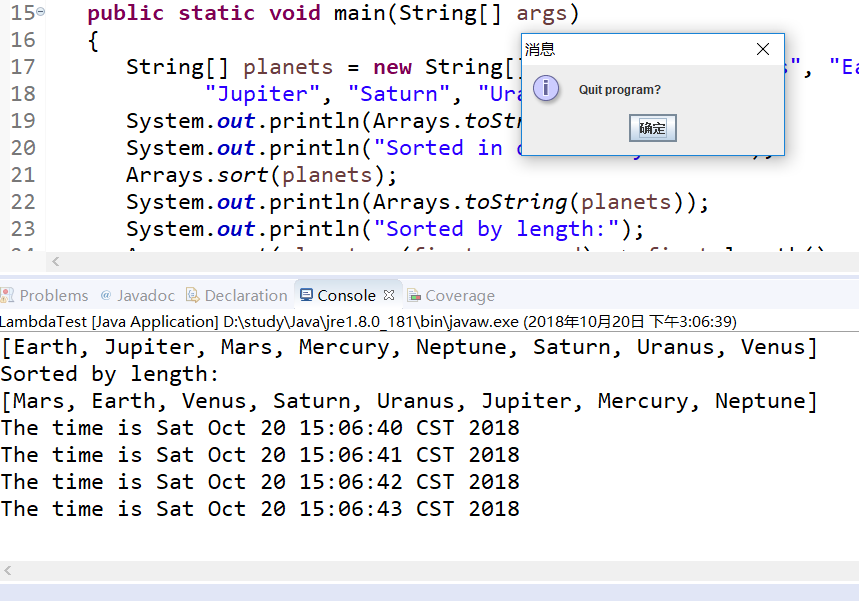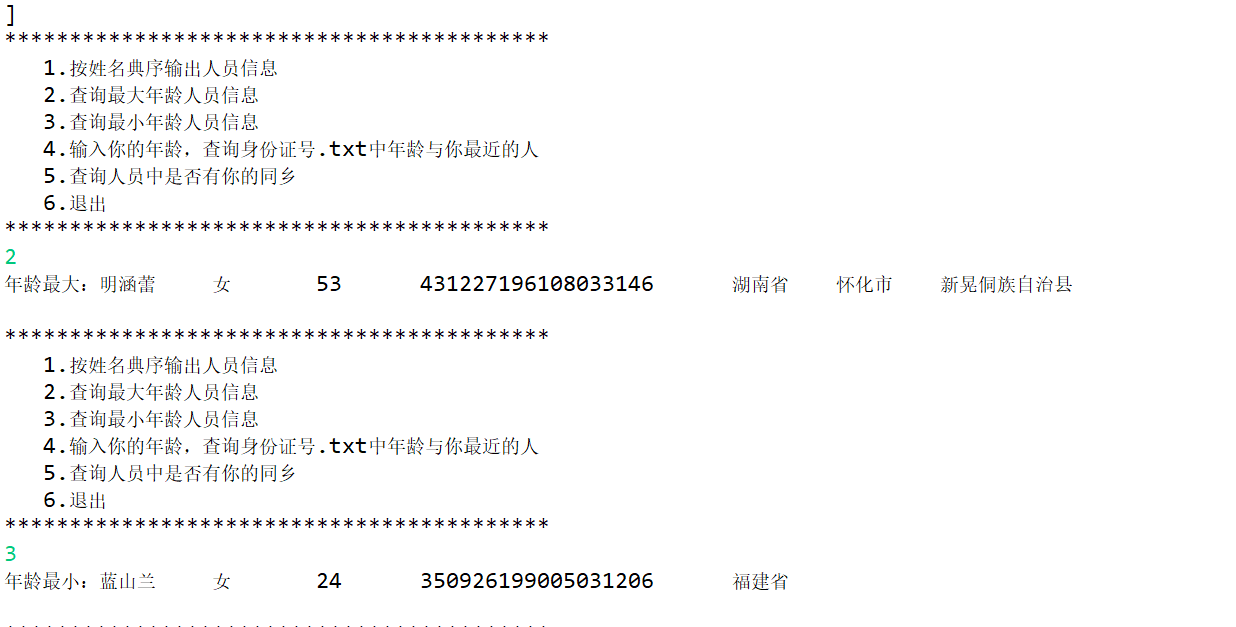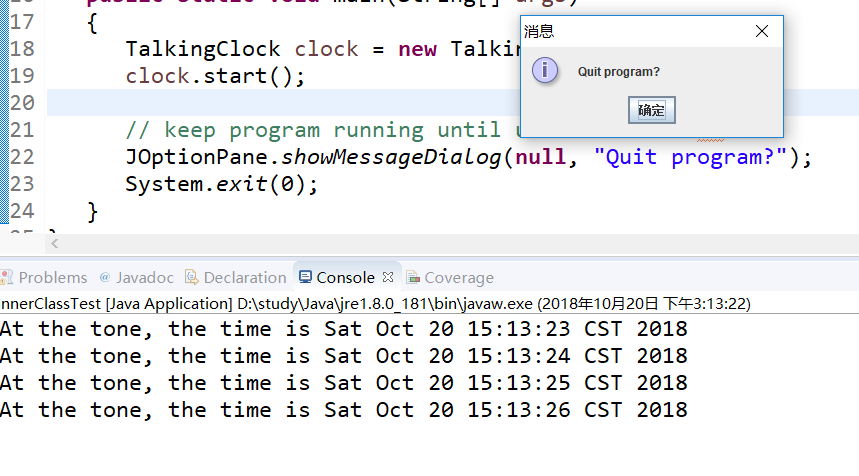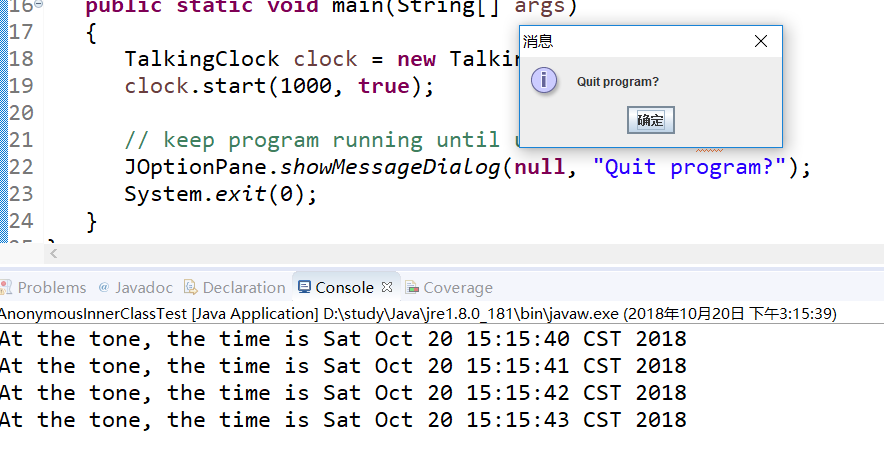第一部分:理论知识学习部分
第六章
第六章知识点主要分为1. 接口 2. lambda表达式 3. 内部类 4. 代理
1. 接口
1) Java为了克服单继承的缺点,Java使用了接口, 一个类可以实现一个或多个接口。
2) 在Java程序设计语言中,接口不是类,而是对类 的一组需求描述,由常量和一组抽象方法组成。
3) 接口中不包括变量和有具体实现的方法。
4) 只要类实现了接口,则该类要遵从接口描述的统 一格式进行定义,并且可以在任何需要该接口的 地方使用这个类的对象。
5)声明方式: public interface 接口名 { …… } 接口体中包含常量定义和方法定义,接口中只进 行方法的声明,不提供方法的实现。
6)类似建立类的继承关系,接口也可以扩展。 接口的扩展技术使得从具有较高通用性的接口存在 多条链延伸到具有较高专用性的接口。
扩展方法: public interface 接口1 extends接口2 { …… }
7)在类声明时用implements关键字声明使用一个或 多个接口
class Employee implementsPrintable { …… }
一个类使用了某个接口,那么这个类必须实现该 接口的所有方法,即为这些方法提供方法体。 一个类可以实现多个接口,接口间应该用逗号分 隔开。
class Employee implements Cloneable,Comparable
8)接口不能构造接口对象,但可以声明接口变量以指向一个实现了该接口的类对象。
Comparablex = new Comparable(…); //ERROR
Comparable x= new Employee(…); //OK
可以用instanceof检查对象是否实现了某个接口。
if (anObjectinstanceofComparable) { ……}
2. 接口与抽象类的区别: (1)接口不能实现任何方法,而抽象类可以。 (2)类可以实现许多接口,但只有一个父类。 (3)接口不是类分级结构的一部分,无任何联系的类可以实现相同的接口。
3. 回调(callback):一种程序设计模式,在这种模式中,可指出某个特定事件发生时程序应该采取的动作。 在java.swing包中有一个Timer类,可以使用它在到达给定的时间间隔时触发一个事件。
Timer(intinterval, ActionListenerlistener)
void start()
void stop()
4. Object类的Clone方法
1)当拷贝一个对象变量时,原始变量与拷贝变量引用同一个对象。这样,改变一个变量所引用 的对象会对另一个变量产生影响。
2)如果要创建一个对象新的copy,它的最初状态与 original一样,但以后可以各自改变状态,就需要使用Object类的clone方法。
5. 浅层拷贝:被拷贝对象的所有常量成员和基本类 型属性都有与原来对象相同的拷贝值,而若成员域是一个对象,则被拷贝对象该对象域的对象引 用仍然指向原来的对象。
深层拷贝:被拷贝对象的所有成员域都含有与原 来对象相同的值,且对象域将指向被复制过的新对 象,而不是原有对象被引用的对象。换言之,深 层拷贝将拷贝对象内引用的对象也拷贝一遍。
6. Java Lambda 表达式是Java 8 引入的一个新的功能,主要用途是提供一个函数化的语法来简化编码。 Lambda表达式本质上是一个匿名方法。
public intadd(intx, inty) { return x + y; } 转成Lambda表达式后是: (intx, inty) -> x + y;
7.内部类(inner class)是定义在一个类内部的类。 外层的类成为外部类(outer class).
内部类主要用于事件处理。 使用内部类的原因有以下三个:
1)内部类方法可以访问该类定义所在的作用域中的数据,包括私有数据。
2)内部类能够隐藏起来,不为同一包中的其他类所见。
3)想要定义一个回调函数且不想编写大量代码时, 使用匿名内部类比较便捷。
第二部分:实验部分 — 接口的定义与使用
实验时间 2018-10-18
1、实验目的与要求
(1) 掌握接口定义方法;
(2) 掌握实现接口类的定义要求;
(3) 掌握实现了接口类的使用要求;
(4) 掌握程序回调设计模式;
(5) 掌握Comparator接口用法;
(6) 掌握对象浅层拷贝与深层拷贝方法;
(7) 掌握Lambda表达式语法;
(8) 了解内部类的用途及语法要求。
2、实验内容和步骤
实验1: 导入第6章示例程序,测试程序并进行代码注释。
测试程序1:
1.编辑、编译、调试运行阅读教材214页-215页程序6-1、6-2,理解程序并分析程序运行结果;
2.在程序中相关代码处添加新知识的注释。
3,掌握接口的实现用法;
4.掌握内置接口Compareable的用法。
EmployeeSortTest程序
1 package interfaces; 2 3 import java.util.*; 4 5 /** 6 * This program demonstrates the use of the Comparable interface. 7 * @version 1.30 2004-02-27 8 * @author Cay Horstmann 9 */ 10 public class EmployeeSortTest 11 { 12 public static void main(String[] args) 13 { 14 Employee[] staff = new Employee[3]; 15 16 staff[0] = new Employee("Harry Hacker", 35000); 17 staff[1] = new Employee("Carl Cracker", 75000); 18 staff[2] = new Employee("Tony Tester", 38000); 19 20 Arrays.sort(staff); 21 22 // 打印所有员工对象的信息 23 for (Employee e : staff) 24 System.out.println("name=" + e.getName() + ",salary=" + e.getSalary()); 25 } 26 }
Employee程序
1 package interfaces; 2 3 //将类声明为实现为某个接口,使用implements关键字 4 public class Employee implements Comparable<Employee> 5 { 6 private String name; 7 private double salary; 8 9 public Employee(String name, double salary) 10 { 11 this.name = name; 12 this.salary = salary; 13 } 14 15 public String getName() 16 { 17 return name; 18 } 19 20 public double getSalary() 21 { 22 return salary; 23 } 24 25 public void raiseSalary(double byPercent) 26 { 27 double raise = salary * byPercent / 100; 28 salary += raise; 29 } 30 31 /** 32 * Compares employees by salary 33 * @param other another Employee object 34 * @return a negative value if this employee has a lower salary than 35 * otherObject, 0 if the salaries are the same, a positive value otherwise 36 */ 37 public int compareTo(Employee other) 38 { 39 // 这里使用了静态Double.compare方法,且为泛型Comparable提供了一个类型参数 40 return Double.compare(salary, other.salary); 41 } 42 }
实验结果:

测试程序2:
编辑、编译、调试以下程序,结合程序运行结果理解程序
1 interface A 2 { 3 double g=9.8; 4 void show( ); 5 } 6 class C implements A 7 { 8 public void show( ) 9 {System.out.println("g="+g);} 10 } 11 12 class InterfaceTest 13 { 14 public static void main(String[ ] args) 15 { 16 A a=new C( ); 17 a.show( ); 18 System.out.println("g="+C.g); 19 } 20 }
实验结果:

测试程序3:
1.在elipse IDE中调试运行教材223页6-3,结合程序运行结果理解程序;
2.26行、36行代码参阅224页,详细内容涉及教材12章。
3.在程序中相关代码处添加新知识的注释。
4.掌握回调程序设计模式;
6-3代码如下:
1 /** 2 @version 1.01 2015-05-12 3 @author Cay Horstmann 4 */ 5 6 import java.awt.*; 7 import java.awt.event.*; 8 import java.util.*; 9 import javax.swing.*; 10 import javax.swing.Timer; 11 // 用JavaUTIL计时器解决冲突 12 13 public class TimerTest 14 { 15 public static void main(String[] args) 16 { 17 ActionListener listener = new TimePrinter(); 18 19 // 构建一个调用侦听器的计时器 20 // 每十秒一次 21 Timer t = new Timer(10000, listener); 22 t.start(); 23 24 JOptionPane.showMessageDialog(null, "Quit program?"); 25 System.exit(0); 26 } 27 } 28 29 class TimePrinter implements ActionListener 30 { 31 public void actionPerformed(ActionEvent event) 32 { 33 System.out.println("At the tone, the time is " + new Date()); 34 Toolkit.getDefaultToolkit().beep(); 35 } 36 }
实验结果如下:

测试程序4:
1.调试运行教材229页-231页程序6-4、6-5,结合程序运行结果理解程序;
2.在程序中相关代码处添加新知识的注释。
3.掌握对象克隆实现技术;
4.掌握浅拷贝和深拷贝的差别。
6-4程序如下:
1 package clone; 2 3 /** 4 * This program demonstrates cloning. 5 * @version 1.10 2002-07-01 6 * @author Cay Horstmann 7 */ 8 //克隆了employee中的一个实例,调用了两个更改器的方法 9 public class CloneTest 10 { 11 public static void main(String[] args) 12 { 13 try 14 { 15 Employee original = new Employee("John Q. Public", 50000); 16 original.setHireDay(2000, 1, 1); 17 Employee copy = original.clone(); 18 copy.raiseSalary(10);//raiseSalary方法改变salary域的值 19 copy.setHireDay(2002, 12, 31);//setHireDay改变hireday域的状态 20 System.out.println("original=" + original); 21 System.out.println("copy=" + copy); 22 } 23 catch (CloneNotSupportedException e) 24 { 25 e.printStackTrace(); 26 } 27 } 28 }
6-5程序如下:
1 package clone; 2 3 import java.util.Date; 4 import java.util.GregorianCalendar; 5 6 public class Employee implements Cloneable 7 { 8 private String name; 9 private double salary; 10 private Date hireDay; 11 12 public Employee(String name, double salary) 13 { 14 this.name = name; 15 this.salary = salary; 16 hireDay = new Date(); 17 } 18 19 public Employee clone() throws CloneNotSupportedException 20 { 21 // 调用对象clone 22 Employee cloned = (Employee) super.clone(); 23 24 // 克隆可变字段 25 cloned.hireDay = (Date) hireDay.clone(); 26 27 return cloned; 28 } 29 30 /** 31 * Set the hire day to a given date. 32 * @param year the year of the hire day 33 * @param month the month of the hire day 34 * @param day the day of the hire day 35 */ 36 public void setHireDay(int year, int month, int day) 37 { 38 Date newHireDay = new GregorianCalendar(year, month - 1, day).getTime(); 39 40 // 实例字段突变示例 41 hireDay.setTime(newHireDay.getTime()); 42 } 43 44 public void raiseSalary(double byPercent) 45 { 46 double raise = salary * byPercent / 100; 47 salary += raise; 48 } 49 50 public String toString() 51 { 52 return "Employee[name=" + name + ",salary=" + salary + ",hireDay=" + hireDay + "]"; 53 } 54 }
实验结果如下:

实验2: 导入第6章示例程序6-6,学习Lambda表达式用法。
1.调试运行教材233页-234页程序6-6,结合程序运行结果理解程序;
2.在程序中相关代码处添加新知识的注释。
将27-29行代码与教材223页程序对比,将27-29行代码与此程序对比,体会Lambda表达式的优点。
6-6程序如下:
1 package lambda; 2 3 import java.util.*; 4 5 import javax.swing.*; 6 import javax.swing.Timer; 7 8 /** 9 * This program demonstrates the use of lambda expressions. 10 * @version 1.0 2015-05-12 11 * @author Cay Horstmann 12 */ 13 public class LambdaTest 14 { 15 public static void main(String[] args) 16 { 17 String[] planets = new String[] { "Mercury", "Venus", "Earth", "Mars", 18 "Jupiter", "Saturn", "Uranus", "Neptune" }; 19 System.out.println(Arrays.toString(planets)); 20 System.out.println("Sorted in dictionary order:"); 21 Arrays.sort(planets); 22 System.out.println(Arrays.toString(planets)); 23 System.out.println("Sorted by length:"); 24 Arrays.sort(planets, (first, second) //先指定类型,再计算表达式 25 -> first.length() - second.length()); 26 System.out.println(Arrays.toString(planets)); 27 28 Timer t = new Timer(1000, event 29 ->System.out.println("The time is " + new Date())); 30 t.start(); 31 32 // 保持程序运行直到用户选择“OK” 33 JOptionPane.showMessageDialog(null, "Quit program?"); 34 System.exit(0); 35 } 36 }
实验结果如下:

实验3: 编程练习
1.编制一个程序,将身份证号.txt 中的信息读入到内存中;
2.按姓名字典序输出人员信息;
3.查询最大年龄的人员信息;
4.查询最小年龄人员信息;
5.输入你的年龄,查询身份证号.txt中年龄与你最近人的姓名、身份证号、年龄、性别和出生地;
6.查询人员中是否有你的同乡。
实验代码如下:
1 package IDcard; 2 3 import java.io.BufferedReader; 4 import java.io.File; 5 import java.io.FileInputStream; 6 import java.io.FileNotFoundException; 7 import java.io.IOException; 8 import java.io.InputStreamReader; 9 import java.util.ArrayList; 10 import java.util.Scanner; 11 import java.util.Collections; 12 13 public class ID { 14 15 public static People findPeopleByname(String name) { 16 People flag = null; 17 for (People people : peoplelist) { 18 if(people.getName().equals(name)) { 19 flag = people; 20 } 21 } 22 return flag; 23 24 } 25 26 public static People findPeopleByid(String id) { 27 People flag = null; 28 for (People people : peoplelist) { 29 if(people.getnumber().equals(id)) { 30 flag = people; 31 } 32 } 33 return flag; 34 35 } 36 37 private static ArrayList<People> agenear(int yourage) { 38 // TODO Auto-generated method stub 39 int j=0,min=53,d_value=0,k = 0; 40 ArrayList<People> plist = new ArrayList<People>(); 41 for (int i = 0; i < peoplelist.size(); i++) { 42 d_value = peoplelist.get(i).getage() > yourage ? 43 peoplelist.get(i).getage() - yourage : yourage - peoplelist.get(i).getage() ; 44 k = d_value < min ? i : k; 45 min = d_value < min ? d_value : min; 46 } 47 for(People people : peoplelist) { 48 if(people.getage() == peoplelist.get(k).getage()) { 49 plist.add(people); 50 } 51 } 52 return plist; 53 } 54 55 private static ArrayList<People> peoplelist; 56 57 public static void main(String[] args) { 58 peoplelist = new ArrayList<People>(); 59 Scanner scanner = new Scanner(System.in); 60 File file = new File("D:\身份证号.txt"); 61 try { 62 FileInputStream files = new FileInputStream(file); 63 BufferedReader in = new BufferedReader(new InputStreamReader(files)); 64 String temp = null; 65 while ((temp = in.readLine()) != null) { 66 67 String[] information = temp.split("[ ]+"); 68 People people = new People(); 69 people.setName(information[0]); 70 people.setnumber(information[1]); 71 int A = Integer.parseInt(information[3]); 72 people.setage(A); 73 people.setsex(information[2]); 74 for(int j = 4; j<information.length;j++) { 75 people.setplace(information[j]); 76 } 77 peoplelist.add(people); 78 79 } 80 } catch (FileNotFoundException e) { 81 System.out.println("文件未找到"); 82 e.printStackTrace(); 83 } catch (IOException e) { 84 System.out.println("文件读取错误"); 85 e.printStackTrace(); 86 } 87 boolean isTrue = true; 88 while (isTrue) { 89 90 System.out.println("******************************************"); 91 System.out.println(" 1.按姓名典序输出人员信息"); 92 System.out.println(" 2.查询最大年龄人员信息"); 93 System.out.println(" 3.查询最小年龄人员信息"); 94 System.out.println(" 4.输入你的年龄,查询身份证号.txt中年龄与你最近的人"); 95 System.out.println(" 5.查询人员中是否有你的同乡"); 96 System.out.println(" 6.退出"); 97 System.out.println("******************************************"); 98 int nextInt = scanner.nextInt(); 99 switch (nextInt) { 100 case 1: 101 Collections.sort(peoplelist); 102 System.out.println(peoplelist.toString()); 103 break; 104 case 2: 105 int max=0; 106 int j,k1 = 0; 107 for(int i=1;i<peoplelist.size();i++) 108 { 109 j = peoplelist.get(i).getage(); 110 if(j>max) 111 { 112 max = j; 113 k1 = i; 114 } 115 116 } 117 System.out.println("年龄最大:"+peoplelist.get(k1)); 118 break; 119 case 3: 120 int min = 100; 121 int j1,k2 = 0; 122 for(int i=1;i<peoplelist.size();i++) 123 { 124 j1 = peoplelist.get(i).getage(); 125 if(j1<min) 126 { 127 min = j1; 128 k2 = i; 129 } 130 131 } 132 System.out.println("年龄最小:"+peoplelist.get(k2)); 133 break; 134 case 4: 135 System.out.println("年龄:"); 136 int input_age = scanner.nextInt(); 137 ArrayList<People> plist = new ArrayList<People>(); 138 plist = agenear(input_age); 139 for(People people : plist) { 140 System.out.println(people.toString()); 141 } 142 break; 143 case 5: 144 System.out.println("请输入省份"); 145 String find = scanner.next(); 146 for (int i = 0; i <peoplelist.size(); i++) 147 { 148 String [] place = peoplelist.get(i).getplace().split(" "); 149 for(String temp : place) { 150 if(find.equals(temp)) { 151 System.out.println("你的同乡是 "+peoplelist.get(i)); 152 break; 153 } 154 } 155 156 } 157 break; 158 case 6: 159 isTrue = false; 160 System.out.println("byebye!"); 161 break; 162 default: 163 System.out.println("输入有误"); 164 } 165 } 166 } 167 168 }
1 package IDcard; 2 3 public class People implements Comparable<People> { 4 5 private String name = null; 6 private String number = null; 7 private int age = 0; 8 private String sex = null; 9 private String place = null; 10 11 public String getName() 12 { 13 return name; 14 } 15 public void setName(String name) 16 { 17 this.name = name; 18 } 19 public String getnumber() 20 { 21 return number; 22 } 23 public void setnumber(String number) 24 { 25 this.number = number; 26 } 27 public int getage() 28 { 29 return age; 30 } 31 public void setage(int age ) 32 { 33 this.age = age; 34 } 35 public String getsex() 36 { 37 return sex; 38 } 39 public void setsex(String sex ) 40 { 41 this.sex = sex; 42 } 43 public String getplace() 44 { 45 return place; 46 } 47 public void setplace(String place) 48 { 49 if(this.place == null) { 50 this.place = place; 51 }else { 52 this.place = this.place+ " " +place; 53 } 54 55 } 56 public int compareTo(People o) 57 { 58 return this.name.compareTo(o.getName()); 59 } 60 public String toString() 61 { 62 return name+" "+sex+" "+age+" "+number+" "+place+" "; 63 } 64 }
实验结果如下:




实验4:内部类语法验证实验
实验程序1:
1.编辑、调试运行教材246页-247页程序6-7,结合程序运行结果理解程序;
2.了解内部类的基本用法。
6-7程序如下:
1 package innerClass; 2 3 import java.awt.*; 4 import java.awt.event.*; 5 import java.util.*; 6 import javax.swing.*; 7 import javax.swing.Timer; 8 9 /** 10 * This program demonstrates the use of inner classes. 11 * @version 1.11 2015-05-12 12 * @author Cay Horstmann 13 */ 14 public class InnerClassTest 15 { 16 public static void main(String[] args) 17 { 18 TalkingClock clock = new TalkingClock(1000, true); 19 clock.start(); 20 21 // keep program running until user selects "Ok" 22 JOptionPane.showMessageDialog(null, "Quit program?"); 23 System.exit(0); 24 } 25 } 26 27 /** 28 * A clock that prints the time in regular intervals. 29 */ 30 class TalkingClock 31 { 32 private int interval; 33 private boolean beep; 34 35 /** 36 * Constructs a talking clock 37 * @param interval the interval between messages (in milliseconds) 38 * @param beep true if the clock should beep 39 */ 40 public TalkingClock(int interval, boolean beep) 41 { 42 this.interval = interval; 43 this.beep = beep; 44 } 45 46 /** 47 * Starts the clock. 48 */ 49 public void start() 50 { 51 ActionListener listener = new TimePrinter(); 52 Timer t = new Timer(interval, listener); 53 t.start(); 54 } 55 56 public class TimePrinter implements ActionListener 57 { 58 public void actionPerformed(ActionEvent event) 59 { 60 System.out.println("At the tone, the time is " + new Date()); 61 if (beep) Toolkit.getDefaultToolkit().beep(); 62 } 63 } 64 }
实验结果如下:

实验程序2:
1.编辑、调试运行教材254页程序6-8,结合程序运行结果理解程序;
2.了解匿名内部类的用法。
6-8程序如下:
1 package anonymousInnerClass; 2 3 import java.awt.*; 4 import java.awt.event.*; 5 import java.util.*; 6 import javax.swing.*; 7 import javax.swing.Timer; 8 9 /** 10 * This program demonstrates anonymous inner classes. 11 * @version 1.11 2015-05-12 12 * @author Cay Horstmann 13 */ 14 public class AnonymousInnerClassTest 15 { 16 public static void main(String[] args) 17 { 18 TalkingClock clock = new TalkingClock(); 19 clock.start(1000, true); 20 21 // keep program running until user selects "Ok" 22 JOptionPane.showMessageDialog(null, "Quit program?"); 23 System.exit(0); 24 } 25 } 26 27 /** 28 * A clock that prints the time in regular intervals. 29 */ 30 class TalkingClock 31 { 32 /** 33 * Starts the clock. 34 * @param interval the interval between messages (in milliseconds) 35 * @param beep true if the clock should beep 36 */ 37 public void start(int interval, boolean beep) 38 { 39 ActionListener listener = new ActionListener() 40 { 41 public void actionPerformed(ActionEvent event) 42 { 43 System.out.println("At the tone, the time is " + new Date()); 44 if (beep) Toolkit.getDefaultToolkit().beep(); 45 } 46 }; 47 Timer t = new Timer(interval, listener); 48 t.start(); 49 } 50 }
实验结果如下:

实验程序3:
1.在elipse IDE中调试运行教材257页-258页程序6-9,结合程序运行结果理解程序;
2.了解静态内部类的用法。
6-9程序如下:
1 package staticInnerClass; 2 3 /** 4 * This program demonstrates the use of static inner classes. 5 * @version 1.02 2015-05-12 6 * @author Cay Horstmann 7 */ 8 public class StaticInnerClassTest 9 { 10 public static void main(String[] args) 11 { 12 double[] d = new double[20]; 13 for (int i = 0; i < d.length; i++) 14 d[i] = 100 * Math.random(); 15 ArrayAlg.Pair p = ArrayAlg.minmax(d); 16 System.out.println("min = " + p.getFirst()); 17 System.out.println("max = " + p.getSecond()); 18 } 19 } 20 21 class ArrayAlg 22 { 23 /** 24 * A pair of floating-point numbers 25 */ 26 public static class Pair 27 { 28 private double first; 29 private double second; 30 31 /** 32 * Constructs a pair from two floating-point numbers 33 * @param f the first number 34 * @param s the second number 35 */ 36 public Pair(double f, double s) 37 { 38 first = f; 39 second = s; 40 } 41 42 /** 43 * Returns the first number of the pair 44 * @return the first number 45 */ 46 public double getFirst() 47 { 48 return first; 49 } 50 51 /** 52 * Returns the second number of the pair 53 * @return the second number 54 */ 55 public double getSecond() 56 { 57 return second; 58 } 59 } 60 61 /** 62 * Computes both the minimum and the maximum of an array 63 * @param values an array of floating-point numbers 64 * @return a pair whose first element is the minimum and whose second element 65 * is the maximum 66 */ 67 public static Pair minmax(double[] values) 68 { 69 double min = Double.POSITIVE_INFINITY; 70 double max = Double.NEGATIVE_INFINITY; 71 for (double v : values) 72 { 73 if (min > v) min = v; 74 if (max < v) max = v; 75 } 76 return new Pair(min, max); 77 } 78 }
实验结果如下:

第三部分:总结
通过本周的学习我收益很多,比如,知道了接口和继承之间的区别,object类的clone方法等,并在助教学长的指导下改善了上周测试题中的不足。本周的实验主要还是以理解课本中的代码案例为主,老师为了节省我们的时间,自主完成实验也只是在以前实验的基础上添加了新的知识内容,在课后探讨学习中助教学长给我们详细讲解了不理解的地方,拓展了我们的视野,展示了Java做工程的强大能力。更加加深了我们对Java的学习兴趣。